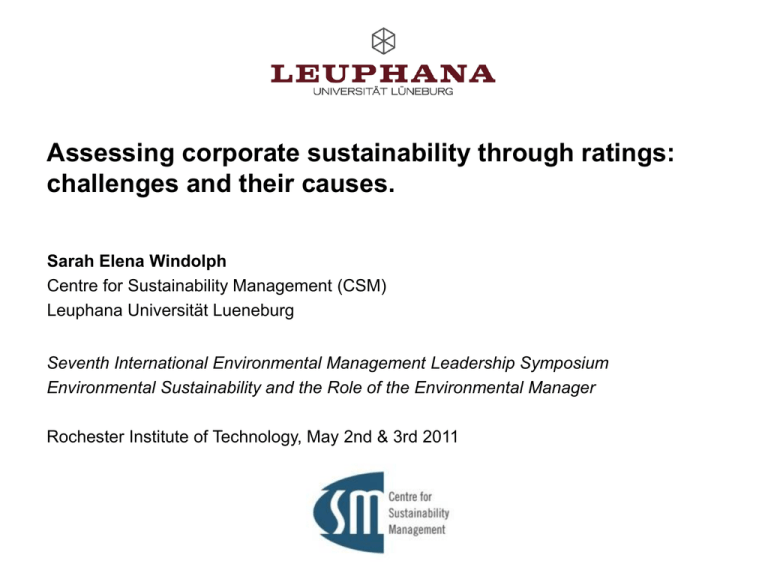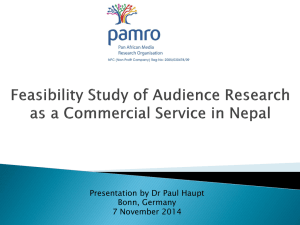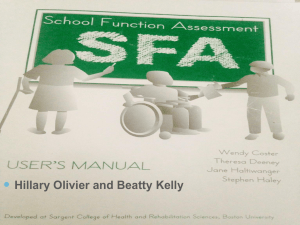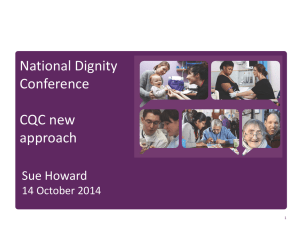Assessing-Corporate - Environmental sustainability
advertisement

Assessing corporate sustainability through ratings: challenges and their causes. Sarah Elena Windolph Centre for Sustainability Management (CSM) Leuphana Universität Lueneburg Seventh International Environmental Management Leadership Symposium Environmental Sustainability and the Role of the Environmental Manager Rochester Institute of Technology, May 2nd & 3rd 2011 Structure of the paper. ■ Introduction ■ Background: relevance of corporate sustainability ratings in theory and practice ■ Challenges for CS ratings ■ Discussion: are the identified challenges rating-specific? ■ Conclusion: are CS ratings suitable to assess CS? ■ References Sarah Elena Windolph 2 Introduction. ■ Corporate sustainability (CS) increasingly important, push and pull ■ Consequence: more reporting, more external assessment ■ But: assessment ambitious, no best practice ■ Confusing multitude of approaches (rankings, ratings, indexes, further studies, etc.) ■ Conclusion: external assessment not suitable? ■ Discussion using the example of ratings (important approach, market, serve for other approaches) ■ Research question: what challenges do CS ratings face and what are their causes? Are they rating-specific? Sarah Elena Windolph 3 Background: Relevance of ratings in theory and practice. 1/2 Relevance of external CS assessment (‘screening’) ■ Companies’ sustainability claims cannot be verified: information asymmetries, possible “market for lemons” (Akerlof, 1970; Rischkowsky & Döring, 2008) ■ Economics of Information (Stigler, 1961; Shapiro, 1982; Stiglitz, 2000) and Principal-Agent Theory (Jensen & Meckling, 1976; Hill & Jones, 1992) deal with possible solutions ■ Possibility 1: signaling (Spence, 1973), e.g. reports cs socially desired, risk of opportunistic behavior, signaling possibly insufficient ■ Possibility 2: screening (Stiglitz, 1975); third party organizations gather information more promising ■ Paper focuses on ratings as practice-relevant screening approach Sarah Elena Windolph 4 Background: Relevance of ratings in theory and practice. 2/2 Development of the CS rating market ■ Most ratings developed within the last ten years ■ Several rating organizations (conventional and sustainability-focused analysts) ■ New market, no regulation ■ Confusing variety of approaches ■ Criticised in research and practice (methodology, criteria, etc.) Sarah Elena Windolph 5 Challenges for CS ratings. ■ Standardization: diversity of approaches and results, no evaluation of approaches, no comparability (Beloe et al., 2004; Graafland et al., 2004; Chatterji et al., 2009) ■ Transparency: rarely full disclosure of criteria, threshold values, measures, etc. (Graafland et al., 2004; Fowler & Hope, 2007; Chatterji et al., 2009; Delmas & Blass, 2010) ■ Bias: emphasis on economic, environmental, or social dimension; investors’ needs and large companies (Beloe et al., 2004; Fowler & Hope, 2007; Chatterji & Toffel, 2010) ■ Weighting tradeoffs: aim at single score, possible overcompensation of unsatisfactory partial results (Graafland et al., 2004; Delmas & Blass, 2010) ■ Credibility of information: companies can influence rating results, missing verification of information (Healy & Palepu, 2001; Beloe et al., 2004; Fowler & Hope, 2007) ■ Indepedendence: relation between rating organizations and companies (Healy & Palepu, 2001; Beloe et al., 2004; AI CSRR, 2008/2009) Sarah Elena Windolph 6 Discussion: Are the identified challenges rating-specific? 1/3 Challenge ■ Standardization Cause complexity of CS (Elkington, 1997; Stahlmann & Clausen, 2000; Schaltegger & Burritt, 2005; Wiedmann et al., 2009) ■ Credibility of information lack of data availability (Lyon and Maxwell, 2006; Chatterji & Levine, 2006) Challenges not rating-specific, general challenges for CS assessment Sarah Elena Windolph 7 Discussion: Are the identified challenges rating-specific? 2/3 Challenge Cause ■ Bias varying stakeholder interests; contradicts the integrative and evaluative character of CS (Schaltegger & Burritt, 2005) ■ Weighting tradeoffs demand for simple and comprehensible results; contradicts the process character of CS (Epstein, 2008; Schaltegger & Burritt, 2005; Ron, 1998) Challenges partly rating-specific, result from needs of investors as ratings’ main users (economic bias, demand for comparable and simple results) Sarah Elena Windolph 8 Discussion: Are the identified challenges rating-specific? 3/3 Challenge ■ Transparency Cause competitive market for ratings (Beloe et al., 2004; Jahn et al., 2005; Globescan, 2010) ■ Independency/objectivity diversity of rating organizations’ business (Graafland et al., 2004; Epstein, 2008; Globescan, 2010; Sadowski et al., 2010) Challenges partly rating-specific, organizations with further relations to assessed companies are particularly affected (typical for financial service providers), similar for audits, certificates Sarah Elena Windolph 9 Conclusion: Are CS ratings suitable to assess CS? ■ CS ratings show several weaknesses, but none rating-specific: – Some: general challenges when assessing CS (standardization, credibility) – Some: result from demand of the practice (bias, weighting tradeoffs) – Some: result from variety of business (relations) of rating organizations (transparency, independence), also apply to other assessment approaches Ratings already practice-relevant, promising, ongoing process ■ Possible developments to increase reliability: – increase transparency: disclose methods, measures, surveys – increase independence: at least disclose, at best avoid conflicting business – reduce biases/weighting tradeoffs: design ratings for more stakeholders – general challenges: depend on contribution of various disciplines and actors Sarah Elena Windolph 10 Food for thought: Implications for Sustainability Managers ■ Engage with ratings? ■ Systematically collect information needed for ratings? ■ Ratings as a way to foster corporate sustainability? ■ Ratings as a way to communicate environmental or sustainability efforts? ■ Influence ratings‘ development? ■ … Sarah Elena Windolph 11 Thank you! References. ■ AI CSRR (Association for Independent Corporate Sustainability & Responsibility Research) (2008/2009): CSRR-QS 2.1. Voluntary Quality Standard for Corporate Sustainability & Responsibility Research (CSRR) Groups, www.csrr-qs.org/pdf/CSRR_QS_2_1_FINAL.pdf (23.02.2011). ■ Akerlof, G. A. (1970): The Market for "Lemons": Quality Uncertainty and the Market Mechanism, Quarterly Journal of Economics, Vol. 84, No. 3, 488–500. ■ Beloe, S.; Scherer, J. & Knoepfel, I. (2004): Values for Money: Reviewing the Quality of SRI Research. London/Stockholm: SustainAbility/Mistra. ■ Chatterji, A. K. & Levine, D. I. (2006): Breaking Down the Wall of Codes. Evaluating Non-financial Performance Measurement, California Management Review, Vol. 48, No. 2, 29-51. ■ Chatterji, A. K.; Levine, D. I. & Toffel, M. W. (2009): How well do social ratings actually measure corporate social responsibility?, Journal of Economics & Management Strategy, Vol. 18, No. 11, 125–169. ■ Chatterji, A. K. & Toffel, M. W. (2010): How firms respond to being rated, Strategic Management Journal, Vol. 31, No. 9, 917–945. ■ Delmas, M. & Blass, V. D. (2010): Measuring corporate environmental performance: the trade-offs of sustainability ratings, Business Strategy and the Environment, Vol. 19, No. 4, 245–260. ■ Elkington, J. (1997): Cannibals with Forks: The triple bottom line of 21st century business. Oxford: Capstone. ■ Epstein, M. J. (2008): Making sustainability work: best practices in managing and measuring corporate social, environmental, and economic impacts. Sheffield: Greenleaf Publishing. ■ Fowler, S. J. & Hope, C. (2007): A Critical Review of Sustainable Business Indices and their Impact, Journal of Business Ethics, Vol. 76, No. 3, 243–252. ■ Globescan (2010): Experts Trust Ratings Organizations Less Than NGOs and Employees as Judges of Sustainability Performance, www.globescan.com/news_archives/tss2010_ratings_orgs (22.02.2011). ■ Graafland, J.; Eijffinger S. C. & Smid, H. (2004): Benchmarking of Corporate Social Responsibility: Methodological Problems and Robustness, Journal of Business Ethics, Vol. 53, No. 1/2, 137–152. ■ Healy, P. & Palepu, K. (2001): Information asymmetry, corporate disclosure, and the capital markets: A review of the empirical disclosure literature, Journal of Accounting and Economics, Vol. 31, No. 1-3, 405–440. ■ Hill, C. W. L. & Jones, T. M. (1992): Stakeholder-Agency Theory, Journal of Management Studies, Vol. 29, No. 2, 131–154. Sarah Elena Windolph 13 References. ■ Jahn, G.; Schramm, M. & Spiller, A. (2005): The Reliability of Certification: Quality Labels as a Consumer Policy Tool, Journal of Consumer Policy, Vol. 28, No. 1, 53–73. ■ Jensen, M. C. & Meckling, W. H. (1976): Theory of the Firm: Managerial Behavior, Agency Costs and Ownership Structure, Journal of Financial Economics, Vol. 3, No. 4, 305–360. ■ Lyon, T. P. & Maxwell, J. W. (2006): Greenwash: Corporate Environmental Disclosure under Threat of Audit. Ross School of Business Working Paper No. 1055, University of Michigan, ssrn.com/abstract=938988 (22.02.2011). ■ Rischkowsky, F. & Döring, T. (2008): Consumer Policy in a Market Economy: Considerations from the Perspective of the Economics of Information, the New Institutional Economics as well as Behavioural Economics, Journal of Consumer Policy, Vol. 31, No. 3, 285–313. ■ Ron, A. J. de (1998): Sustainable production: The ultimate result of a continuous improvement, International Journal of Production Economics, Vol. 56/57, No. 1, 99–110. ■ Sadowski, M.; Whitaker, K. & Buckingham, F. (2010): Rate the Raters. Phase Two. Taking Inventory of the Ratings Universe, www.sustainability.com/library/rate-the-raters-phase-two (23.02.2011). ■ Schaltegger, S. & Burritt, R. (2005): Corporate Sustainability, in: Folmer, H. & Tietenberg, T. (eds.): The International Yearbook of Environmental and Resource Economics. Cheltenham: Edward Elgar, 185–232 ■ Shapiro, C. (1982): Consumer Information, Product Quality, and Seller Reputation, The Bell Journal of Economics, Vol. 13, No. 1, 20–35. ■ Spence, M. (1973): Job Market Signaling, Quarterly Journal of Economics. Vol. 87, No. 3, 355–374. ■ Stahlmann, V. & Clausen, J. (2000): Umweltleistung von Unternehmen. Von der Öko-Effizienz zur Öko-Effektivität. Wiesbaden: Gabler. ■ Stigler, G. J. (1961): The Economics of Information, The Journal of Political Economy, Vol. 69, No. 3, 213–225. ■ Stiglitz, J. E. (1975): The theory of "screening," education, and the distribution of income, The American Economic Review, Vol. 65, No. 3, 283– 300. ■ Stiglitz, J. E. (2000): The Contributions of the Economics of Information to Twentieth Century Economics, The Quarterly Journal of Economics, Vol. 115, No. 4, 1441–1478. ■ Wiedmann, T. O.; Lenzen, M. & Barrett, J. R. (2009): Companies on the Scale. Comparing and Benchmarking the Sustainability Performance of Businesses, Journal of Industrial Ecology, Vol. 13, No. 3, 361–383. Sarah Elena Windolph 14 Contact. Sarah Elena Windolph Centre for Sustainability Management (CSM) Leuphana University Lüneburg Scharnhorststr. 1 D-21335 Lüneburg windolph@uni.leuphana.de www.leuphana.de/csm Tel. +49 4131 677 2521 Fax +49 4131 677 2186 Sarah Elena Windolph 15









